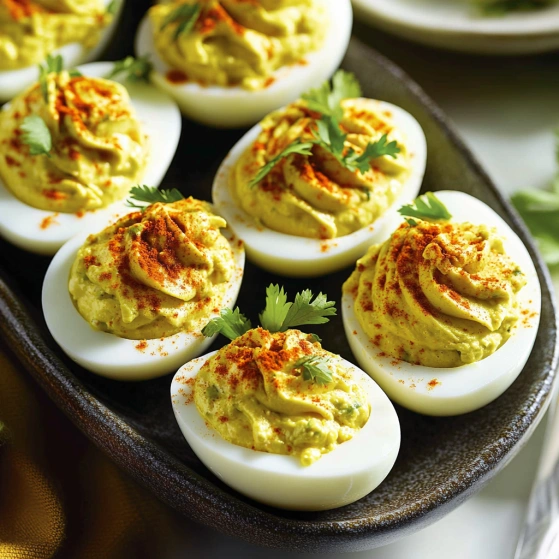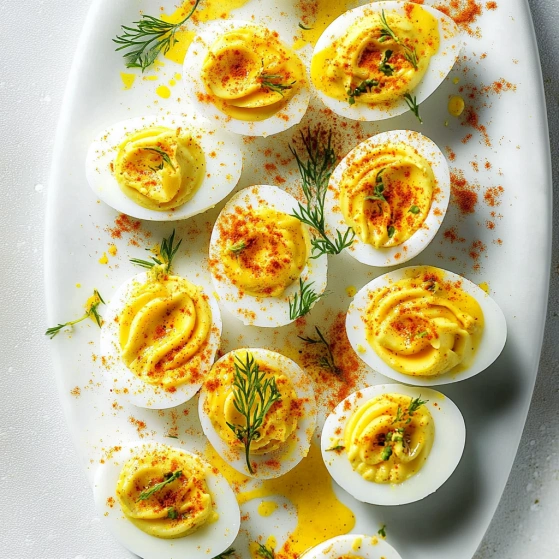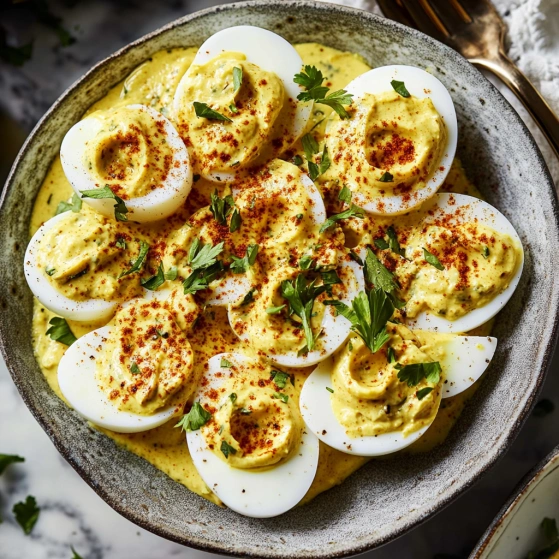 Pin it
Pin it
This curry deviled eggs recipe transforms the classic appetizer into a flavor-packed treat that will intrigue your taste buds and impress your guests. The subtle curry flavor adds warmth and depth to traditional deviled eggs without overwhelming the creamy filling.
I first made these curry deviled eggs for a neighborhood potluck, and they disappeared faster than any other dish on the table. Even people who claimed they weren't deviled egg fans came back for seconds.
Ingredients
- Eggs: Use fresh eggs that are at least a week old as they peel more easily than very fresh eggs
- Mayonnaise: Provides creaminess and richness to the filling
- Dijon mustard: Adds tanginess that balances the curry flavor
- Distilled white vinegar: Brightens all the flavors and cuts through the richness
- Curry powder: The star ingredient that transforms ordinary deviled eggs into something special
- Kosher salt: Enhances all the flavors
- Paprika for garnish: Adds a beautiful color contrast and subtle smoky flavor
- Fresh dill for garnish: Brings freshness and visual appeal
Step-by-Step Instructions
- Boil the Eggs:
- Add eggs to a large pot and cover with water until it reaches about an inch above the eggs. This ensures even cooking throughout.
- Heat and Cover:
- Bring the water to a full boil over high heat. Once boiling, immediately cover the pot and remove from heat. This gentle cooking method prevents the rubbery texture that comes from overcooking.
- Rest and Set:
- Allow the eggs to remain in the hot water for exactly 12 minutes. This precise timing gives you perfectly cooked yolks that are firm but still creamy.
- Ice Bath Preparation:
- While eggs are cooking, prepare a large bowl with very cold water and ice cubes. This bath stops the cooking process immediately.
- Cool the Eggs:
- After the 12 minute cooking time, carefully transfer eggs to the ice bath and let them rest for 10 minutes. This makes peeling much easier and prevents that unappetizing green ring around the yolk.
- Peel with Precision:
- Crack each egg on top and bottom, then roll gently on the counter to create a network of small cracks all over. Peeling under lukewarm running water helps the shell separate cleanly from the egg.
- Slice and Separate:
- Cut each egg lengthwise and carefully separate the yolks from the whites. Place whites on your serving platter.
- Prepare the Filling:
- Combine yolks, mayonnaise, Dijon mustard, vinegar, curry powder, and salt in a food processor. Process until completely smooth and creamy, stopping to scrape down the sides as needed.
- Fill the Eggs:
- Transfer the filling to a piping bag or zip top bag with corner snipped. This gives your eggs a professional, elegant appearance.
- Garnish and Serve:
- Pipe the filling generously into each egg white half. Sprinkle with paprika and fresh dill just before serving for the perfect finishing touch.
 Pin it
Pin it
The curry powder is truly the magical ingredient in this recipe. I discovered this version at an Indian dinner party where the host had blended family traditions with American classics. The subtle warmth of curry transformed these humble eggs into something extraordinary that I now make for every special occasion.
Make Ahead Tips
These curry deviled eggs can be prepared up to one day ahead of serving. Keep the egg white halves and curry filling separate until ready to serve. Store the whites in an airtight container lined with paper towels to absorb excess moisture. Keep the filling in a piping bag or sealed container. Assemble and garnish just before serving for the freshest presentation.
Spice Level Customization
The beauty of this recipe lies in its adaptability to your spice preferences. For a milder version, stick with standard curry powder. For more heat, choose a hot curry powder or add a pinch of cayenne pepper to the filling. You can also experiment with different curry blends like Madras or Vindaloo for varying flavor profiles. My family prefers a medium warmth that enhances rather than overwhelms the eggs.
 Pin it
Pin it
Serving Suggestions
Curry deviled eggs make a standout addition to any appetizer spread or brunch table. They pair wonderfully with crisp vegetables, crusty bread, and charcuterie boards. For an Indian inspired gathering, serve alongside samosas or pakoras. They also make an elegant addition to a tea sandwich platter. I like to arrange them on a bed of fresh herbs with lemon wedges for a beautiful presentation that elevates the humble egg.
Frequently Asked Questions
- → How far in advance can I make curry deviled eggs?
You can prepare curry deviled eggs up to 24 hours in advance. Store the filled eggs in an airtight container in the refrigerator, but add the paprika and dill garnish just before serving for the freshest appearance and flavor.
- → Can I substitute the curry powder with something else?
Yes, you can substitute curry powder with turmeric for color and a milder flavor, or try garam masala for a different aromatic profile. Smoked paprika or cajun seasoning would create entirely different but equally delicious variations.
- → What's the best way to transport deviled eggs to a party?
Use a specialized deviled egg carrier with individual compartments to prevent shifting. Alternatively, place the filled eggs in a container with a tight-fitting lid, using toothpicks inserted halfway into each egg to prevent them from sliding around.
- → Why do my hard-boiled eggs sometimes have a green ring around the yolk?
The green ring forms when eggs are overcooked or not cooled quickly enough, causing a chemical reaction between the sulfur in the egg white and the iron in the yolk. Following the 12-minute cooking time and immediate ice bath as described in this method will prevent this issue.
- → How can I make these deviled eggs healthier?
For a healthier version, you can substitute half or all of the mayonnaise with Greek yogurt. This reduces the fat content while adding protein and maintaining a creamy texture. You could also use light mayonnaise as an alternative.
- → What can I serve with curry deviled eggs?
Curry deviled eggs pair wonderfully with fresh vegetable platters, charcuterie boards, tea sandwiches, or as part of a brunch spread. They also complement Indian-inspired dishes like samosas or pakoras for a themed appetizer selection.
